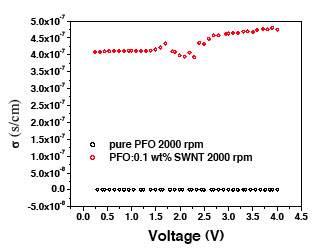Air-stable Nanomaterials for Efficient OLEDs and Solar Cells
Berkeley Lab researchers have developed two approaches for increasing the charge efficiencies of electrodes used to produce flexible organic light emitting diodes (OLEDs) and solar cells. Both approaches will reduce manufacturing and packaging costs. ________________________________________________________ADVANTAGES:
- Solvent processed, ink jet printable - More efficient charge injection and higher conductivity than conventional conducting polymers - Transparent (= ITO film)
- Reduced drive voltage - Compatible with flexible substrates - Longer material lifetimes than devices made with active metal
DESCRIPTION:
A new class of conductive polymers developed at Berkeley Lab uniformly suspends and disperses carbon nanotubes, enabling them to function efficiently as charge injectors in the electrodes and light emitting layers of OLEDs and organic solar cells. Currently, OLEDs cathodes are thermal vacuum evaporated due to the use of reactive metals for electron injection. The use of calcium or lithium also requires air-impenetrable packaging. In contrast, devices made using Berkeley Lab’s air-stable cathode materials can be solvent processed and applied using ink jet printing or spin coating. They also have relaxed packaging requirements.
Unlike most OLEDs that incorporate metals in the cathode, the Berkeley Lab OLEDs are transparent. Transparent OLEDs can be used to display video, images, and other information in applications where the user still can see through the substrate, such as with windshields and windows. While ITO films are also transparent, they are brittle and require plasma deposition. The Berkeley Lab materials are flexible and promise to be low-cost – making inexpensive, roll-up, digital display technology a near-future possibility.
Gao Liu, John Kerr and colleagues have demonstrated initial efficiencies of three percent for OLED devices incorporating the poly(di(oxytrioxadecane)fluorine)(PFO)/nanotube composites, with a clear research path towards significant increases. The nanotubes have remained suspended in the PFO for over four months, far exceeding the six day limit achieved in other nanotube/polymer systems. The suspension is sustainable because the polymer is amphiphilic and wraps its polar side chains around the nanotube. Both the backbone and side chains of the polymer can be adapted to accommodate various applications.
APPLICATIONS :
- OLED displays for consumer electronics, digital video, and medical imaging devices, or built into architectural and automobile windows and flexible plastics - Organic photovoltaics - OLEDs for lighting
ADVANTAGES:
- Enhanced charge injection efficiency and increase conductivity - Reduced drive voltage - Relaxed packaging and manufacturing requirements - Lithographically defined nanostructures - Longer material lifetimes than devices made with active metals - Can be applied to flexible substrates
DESCRIPTION: Scientists at Berkeley Lab have developed electrodes with nanostructured geometry to improve the electrical-optical energy conversion efficiency of flexible OLEDs and solar cells. The new transparent electrodes are less reactive to water and oxygen than their metal counterparts, which will reduce the costs of fabrication and packaging.
The Berkeley Lab scientists employ ordered arrangements of nanotubes or stable nanoclusters at the cathode-organic layer interface as charge injectors to efficiently overcome the large energy barrier at that interface. These structured electrodes promise to significantly reduce the drive voltage necessary to induce light emission inside organic materials and thereby increase the energy conversion efficiency of the resulting devices.
Attached files:

Inventor(s): Gao Liu, John Kerr
Type of Offer: Licensing
« More Solar Patents
